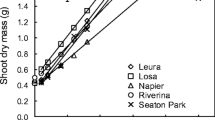Summary
Twenty four populations of timothy (Phleum pratense L.) with varying persistency were grown on a nutrient flow system and in soil. Growth analyses showed that seedlings grew faster on nutrient solution than in soil but this was only temporary. After the fourth cutting, regrowth of plants in soil was faster than on hydroponics, probably because the optimal growth conditions and the relatively high temperatures in the nutrient solution led to a depleted storage carbohydrate pool, necessary for regrowth.
Non-destructive growth analyses were carried out by monitoring the amount of acid needed to compensate for carbohydrate extrusion by the roots in exchange for nitrate uptake. It was assumed that regrowth was proportional to the NO3 - incorporated in the plants. The calculated growth efficiency on hydroponics, averaged over all populations, ranged between 4.4 and 5.4 gram dry matter per megajoule photosynthetic radiation absorbed. The populations responded significantly differently to a frequent cutting regime. As a function of harvest number, the competitive ability of some populations decreased compared with the mean of all populations, while that of others increased or remained stable. The coefficients of genetic variation for shoot regrowth ranged between 0.16–0.22 for different harvests. For root regrowth and tillering the coefficients of genetic variation were even higher: 0.21–0.25 for the roots and 0.18–0.35 for the tiller number. Dry matter production was closely correlated with tiller formation (r=0.95).
The application of nitrogen to the nutrient solution was controlled by a simple computer model, which was based on the incoming radiation and which calculated momentaneous growth of the plants on a minutes time base. Thus an equilibrium between nitrogen application and the demand of the plants was maintained. During the last regrowth period, the nitrogen supply was limited to 30% of the optimal addition rate. The production of different populations under limited supply (sixth harvest) was closely correlated with that under optimal supply (fifth harvest), (r=0.7).
Similar content being viewed by others
References
Alberda, Th., 1965. The influence of temperature, light intensity and nitrate concentration on dry-matter production and chemical composition of Lolium perenne. Neth J Agric Sci 13: 335–360.
Alberda, Th., 1966. The influence of reserve substances on dry-matter production after defoliation. Proc of the tenth International Grassland Congress: 140–147.
Baan Hofman, T. & G.C. Ennik, 1980. Investigation into plant characters affecting the competitive ability of perennial ryegrass (Lolium perenne L.) Neth J Agric Sci 28., 97–109.
Baker, A. & A. Younger, 1987. Factors affecting the leaf extension rate of perennial ryegrass in spring. Grass and Forage Science 42.: 381–390.
Behaege, T.J., 1974. Experiments on the seasonal variation of grass growth. Proc 12th Int Grassl Congr Moscow, 268–281.
Davies, A. & H. Thomas, 1983. Rates of leaf and tiller production in young spaced Perennial ryegrass plants in relation to soil temperature and solar radiation. Ann bot 57: 591–597.
Dijkshoorn, W., 1962. Metabolic regulation of the alkaline effect of nitrate utilization in plants. Nature 194: 165–167.
Ingenstad, T., 1982. Relative addition rate and external concentration: driving variables used in plant nutrition research. Plant, Cell and Environment, 443–453.
Kleinendorst, A. & R. Brouwer, 1969. Growth responses of two clones of perennial rye-grass to excision of roots or shoots. Jaarb IBS, 19–26.
Kleinendorst, A. & R. Brouwer, 1972. The effect of cooling on growth and water content of plants. Neth J Agric Sci: 203–217.
MacDuff, J.H., M.J. Hopper & A. Wild, 1987a. The effect of root temperature on growth and uptake of ammonium and nitrate by Brassica napus L. in flowing solution culture. J Exp Bot 186: 42–52.
MacDuff, J.H., M.J. Hopper & A. Wild, 1987b. The effect of root temperature on growth and uptake of ammonium and nitrate by Brassica napus L. cv. Bien venu in flowing solution culture. J Exp Bot 186: 53–66.
Parsons, A.J. & M.J. Robson, 1980. Seasonal changes in the physiology of S24 perennial ryegrass (Lolium perenne L.) 1. Response of leaf extension to temperature during the transition from vegetative to reproductive growth. Ann Bot 46: 435–444.
Steiner, A.A., 1979. The selective capacity of plants for ions and its importance for the composition and treatment of the nutrient solution. Acta Horticulturae 98: 87–97.
Steiner, A.A., 1983. The possibilities and restrictions of soilless culture. Proc. International seminar on new technologies in food production for the eighties and beyond. Trinidad & Tobago: 43–52.
Wooledge, J. & E.L. Leafe, 1976. Single leaf canopy photosynthesis in a ryegrass sward. Ann Bot, 40: 773–783.
Author information
Authors and Affiliations
Rights and permissions
About this article
Cite this article
Schapendonk, A.H.C.M., de Vos, A.L.F. Implications of selecting for persistency on hydroponics in timothy (Phleum pratense L.). Euphytica 39 (Suppl 3), 131–139 (1988). https://doi.org/10.1007/BF00043376
Received:
Accepted:
Issue Date:
DOI: https://doi.org/10.1007/BF00043376




